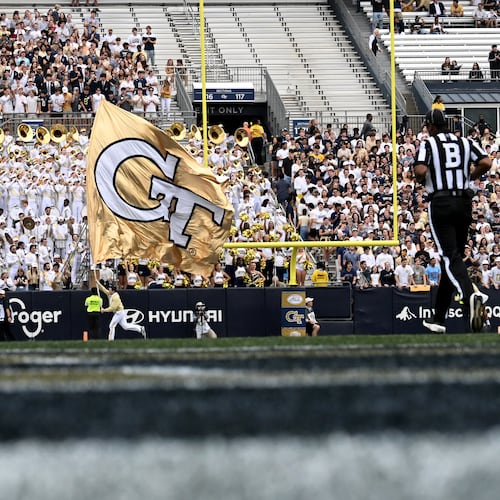At the end of practices, Georgia Tech players often run through a 3-point shooting drill. Players have 90 seconds to make five 3-pointers from each of five spots on the floor, starting in one corner, then the wing, moving to the top of the arc and then the wing and corner on the opposite side. It looks similar to the format used in the 3-point shooting competition at the NBA All-Star weekend, a primary difference being that players can’t move to the next spot until they have made five 3-pointers at the one where they’re at.
And the players on the team that as of Friday ranked 314th in Division I in 3-point shooting accuracy at 30.9% and has been trapped in a slump often whiz through it. Guard Deebo Coleman can make his 25 shots in about 65 seconds, coach Josh Pastner said. Guard Miles Kelly can finish with similar speed. Guard Kyle Sturdivant can complete the circuit in 70 seconds.
“I assure you, when you watch us in practice, even in the shooting drills at game speed, we’re putting it in,” Pastner said Friday. “I just think it’s something about the game where the ball’s just not going in the hoop during the game.”
That would seem an accurate assessment of Tech, which will attempt to break an eight-game losing streak at N.C. State on Saturday. In their past five games, the Yellow Jackets have made 28 of 124 3-point shots, 22.6%. That stretch includes a 2-for-21 effort against the same Wolfpack team that Tech will see Saturday. The 9.5% shooting rate in that game was the second worst by a Jackets team in Pastner’s tenure.
The Jackets’ 3-point difficulties have had the compounding effect of putting more pressure on Tech’s offense closer to the basket, which also is not effective.
In a 68-58 loss Wednesday at Louisville, a game for last place in the league in which the Cardinals broke a 10-game losing streak, Tech seemed to have broken free of their slump by shooting 7-for-16 from 3-point range in the first half, only to miss all 11 tries in the second half. In ACC play, Tech ranks last in field-goal percentage (38.5%), 3-point field-goal percentage (29.7%) and scoring offense (61.2 points per game). The season 3-point shooting rate (30.9%) is not too far off the lowest single-season rate in school history (29.0% in the 1996-97 season), although, remarkably, still better than 10 other power-conference teams.
The issue isn’t that the Jackets are taking shots when they shouldn’t. In that 0-for-11 second half, Pastner said, most of the shots were attempted with little challenge by Louisville. In games previously, also, many of the misses were on shots that were relatively open.
“The biggest thing is, I really think it’s confidence,” Pastner said. “Where you get it through, you make a couple and all of the sudden, not only are we trying to break through the barrier of winning, but the shooting part, breaking through that barrier, too. I think it’s both of those things.”
The 3-point shooting is only one of many shortcomings that have led Tech to its 8-14 record (1-11 in the ACC) and appeared to have placed Pastner’s job in jeopardy in his seventh season. On Friday, he acknowledged the “noise” surrounding the team as fans have not been shy about displaying their dissatisfaction.
“We haven’t had the season to this point that I’ve wanted, that the young men have wanted, our staff has wanted, my bosses have wanted, that Yellow Jacket nation has wanted,” Pastner said.
“I have felt that we were going to be much better than where we are today. Unfortunately, offensively we haven’t been as good as I had assumed or thought we’d be, based on how we were in the summer and in the fall and in early-season things on our shooting. Not scoring at the level that I thought we could maybe score at, especially more on shooting the 3.”
Kelly has some experience with this sort of drought. At the start of his freshman season a year ago, he made five of his first 30 3-point tries (16.7%). Against Division II Clayton State in the 18th game of the season, Kelly finally broke loose, making two of three tries. From that point over the final 14 games, Kelly was 19-for-42 (45.2%).
“I think that was just because of me getting more comfortable with the game and me just knowing where my shots were going to come from, so I was more relaxed and not as timid to shoot the ball,” Kelly said.
The fates have turned the other way this season. Over an 11-game stretch, he was torrid, making at least two 3-pointers in each game and shooting 45.6%. Since that point, he has cooled, making seven of 34 (20.6%) over the past five games.
“I feel like this year, we’re getting a lot of good looks,” Kelly said. “We’ve just got to knock them down. It’s plain and simple like that.”
Kelly’s response has been to keep his routines the same, the ones he followed when he ranked among the hottest shooters in the country.
“I just feel like that’s what got me here, so I’m going to keep doing that,” he said. “That’s just staying in the gym late night, early morning, just working on my game so I can be better in the game.”
About the Author
Keep Reading
The Latest
Featured



